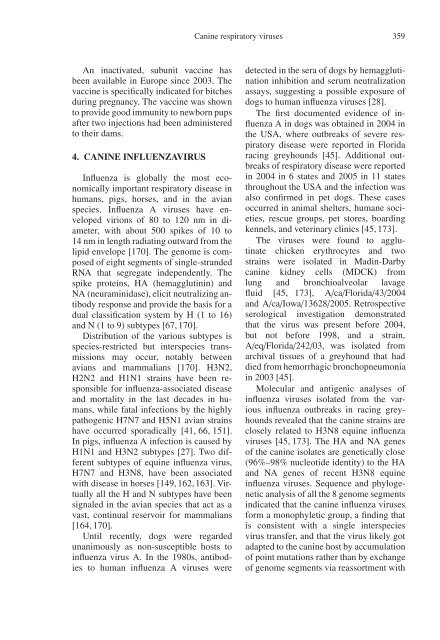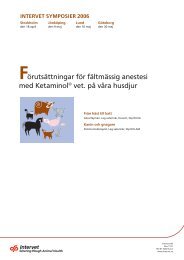KVÄLLSSYMPOSIUM 2008 Vaccinering av hund och katt
KVÄLLSSYMPOSIUM 2008 Vaccinering av hund och katt
KVÄLLSSYMPOSIUM 2008 Vaccinering av hund och katt
You also want an ePaper? Increase the reach of your titles
YUMPU automatically turns print PDFs into web optimized ePapers that Google loves.
An inactivated, subunit vaccine has<br />
been <strong>av</strong>ailable in Europe since 2003. The<br />
vaccine is specifically indicated for bitches<br />
during pregnancy. The vaccine was shown<br />
to provide good immunity to newborn pups<br />
after two injections had been administered<br />
to their dams.<br />
4. CANINE INFLUENZAVIRUS<br />
Influenza is globally the most economically<br />
important respiratory disease in<br />
humans, pigs, horses, and in the <strong>av</strong>ian<br />
species. Influenza A viruses h<strong>av</strong>e enveloped<br />
virions of 80 to 120 nm in diameter,<br />
with about 500 spikes of 10 to<br />
14 nm in length radiating outward from the<br />
lipid envelope [170]. The genome is composed<br />
of eight segments of single-stranded<br />
RNA that segregate independently. The<br />
spike proteins, HA (hemagglutinin) and<br />
NA (neuraminidase), elicit neutralizing antibody<br />
response and provide the basis for a<br />
dual classification system by H (1 to 16)<br />
and N (1 to 9) subtypes [67, 170].<br />
Distribution of the various subtypes is<br />
species-restricted but interspecies transmissions<br />
may occur, notably between<br />
<strong>av</strong>ians and mammalians [170]. H3N2,<br />
H2N2 and H1N1 strains h<strong>av</strong>e been responsible<br />
for influenza-associated disease<br />
and mortality in the last decades in humans,<br />
while fatal infections by the highly<br />
pathogenic H7N7 and H5N1 <strong>av</strong>ian strains<br />
h<strong>av</strong>e occurred sporadically [41, 66, 151].<br />
In pigs, influenza A infection is caused by<br />
H1N1 and H3N2 subtypes [27]. Two different<br />
subtypes of equine influenza virus,<br />
H7N7 and H3N8, h<strong>av</strong>e been associated<br />
with disease in horses [149, 162, 163]. Virtually<br />
all the H and N subtypes h<strong>av</strong>e been<br />
signaled in the <strong>av</strong>ian species that act as a<br />
vast, continual reservoir for mammalians<br />
[164, 170].<br />
Until recently, dogs were regarded<br />
unanimously as non-susceptible hosts to<br />
influenza virus A. In the 1980s, antibodies<br />
to human influenza A viruses were<br />
Canine respiratory viruses 359<br />
detected in the sera of dogs by hemagglutination<br />
inhibition and serum neutralization<br />
assays, suggesting a possible exposure of<br />
dogs to human influenza viruses [28].<br />
The first documented evidence of influenza<br />
A in dogs was obtained in 2004 in<br />
the USA, where outbreaks of severe respiratory<br />
disease were reported in Florida<br />
racing greyhounds [45]. Additional outbreaks<br />
of respiratory disease were reported<br />
in 2004 in 6 states and 2005 in 11 states<br />
throughout the USA and the infection was<br />
also confirmed in pet dogs. These cases<br />
occurred in animal shelters, humane societies,<br />
rescue groups, pet stores, boarding<br />
kennels, and veterinary clinics [45, 173].<br />
The viruses were found to agglutinate<br />
chicken erythrocytes and two<br />
strains were isolated in Madin-Darby<br />
canine kidney cells (MDCK) from<br />
lung and bronchioalveolar l<strong>av</strong>age<br />
fluid [45, 173], A/ca/Florida/43/2004<br />
and A/ca/Iowa/13628/2005. Retrospective<br />
serological investigation demonstrated<br />
that the virus was present before 2004,<br />
but not before 1998, and a strain,<br />
A/eq/Florida/242/03, was isolated from<br />
archival tissues of a greyhound that had<br />
died from hemorrhagic bronchopneumonia<br />
in 2003 [45].<br />
Molecular and antigenic analyses of<br />
influenza viruses isolated from the various<br />
influenza outbreaks in racing greyhounds<br />
revealed that the canine strains are<br />
closely related to H3N8 equine influenza<br />
viruses [45, 173]. The HA and NA genes<br />
of the canine isolates are genetically close<br />
(96%–98% nucleotide identity) to the HA<br />
and NA genes of recent H3N8 equine<br />
influenza viruses. Sequence and phylogenetic<br />
analysis of all the 8 genome segments<br />
indicated that the canine influenza viruses<br />
form a monophyletic group, a finding that<br />
is consistent with a single interspecies<br />
virus transfer, and that the virus likely got<br />
adapted to the canine host by accumulation<br />
of point mutations rather than by exchange<br />
of genome segments via reassortment with





